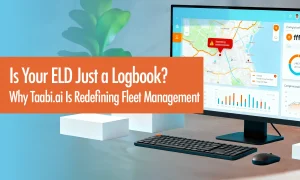Driver fatigue and distraction are two of the most significant factors contributing to road accidents, often with devastating consequences. Recognizing the signs and understanding the risks associated with these states is critical in enhancing road safety, a task greatly aided by the driver behavior monitoring system.
Incorporating driver behavior management software into fleet management strategies amplifies this effectiveness. This software analyzes data collected by the monitoring system to offer a more comprehensive understanding of each driver’s habits and tendencies. It can pinpoint patterns that might indicate fatigue or distraction, allowing for timely measures to mitigate these risks.
These software can also aid in developing customized training and wellness programs for drivers, further Optimizing Driver Performance. By addressing individual needs and behaviors, it ensures that drivers are not only well-trained but also physically and mentally prepared for the demands of the road.
The integration of a driver behavior monitoring system and driver behavior management software into fleet operations is a game changer! It provides a robust framework for identifying, managing, and mitigating the risks of driver fatigue and distraction, ultimately leading to safer roads and improved driver well-being.
The driver behavior monitoring system has revolutionized how fatigue and distraction are detected in drivers, offering a multi-faceted approach to enhancing road safety. Following are the various methods employed by these systems, each contributing uniquely to Optimizing Driver Performance and Driver Management in Fleet operations.
One of the primary methods used by the driver behavior monitoring system is the observation of physiological signs. Technologies such as eye-tracking and heart rate monitoring are employed to detect signs of fatigue. For instance, a decrease in blink rate or an increase in blink duration can signal tiredness. Similarly, changes in heart rate variability may indicate stress or distraction. These physiological indicators provide real-time data, allowing for immediate intervention if necessary.
Incorporating facial recognition technology, driver behavior management software can detect signs of fatigue and distraction by analyzing facial expressions and head movements. Yawning, frequent blinking, and drooping eyelids are tell-tale signs of fatigue. In contrast, distraction may be indicated by the driver’s gaze shifting away from the road or facial expressions suggesting preoccupation.
Beyond physiological and behavioral monitoring, these systems also consider environmental factors. This involves analyzing the driving context, such as the time of day, duration of the trip, and road conditions. For instance, driving for prolonged periods or during typical sleep hours significantly increases the risk of fatigue.
Finally, the integration of data from various sources is crucial in Optimizing Driver Performance. Driver behavior management software synthesizes data from physiological, behavioral, and environmental monitoring to provide a comprehensive view of the driver’s state. This holistic approach ensures that signs of fatigue and distraction are accurately identified, allowing for timely interventions.
The multifaceted methods employed by driver behavior monitoring systems and driver behavior management software play a crucial role in enhancing road safety. By detecting fatigue and distraction through various innovative techniques, these systems contribute significantly to the safety and efficiency of fleet operations.
Integrating alert systems and accident prevention strategies into the driver behavior monitoring system is crucial for enhancing road safety. These systems not only detect signs of fatigue and distraction but also proactively respond to mitigate risks. This section breaks down the various components of these systems and strategies.
A core feature of the driver behavior monitoring system is its ability to provide real-time alerts to drivers. These alerts can take various forms, such as auditory warnings, visual signals, or haptic feedback like seat or steering wheel vibrations. For instance, if the system detects signs of drowsiness, such as prolonged eye closure or head nodding, it immediately alerts the driver, prompting them to take action, such as taking a break or increasing alertness.
Beyond immediate alerts, driver behavior management software uses predictive analysis to anticipate potential risks. By analyzing historical data and current driving patterns, the software can predict scenarios where the risk of fatigue or distraction is higher. This allows fleet managers to implement proactive measures, such as scheduling breaks or adjusting workloads, thereby Optimizing Driver Performance and enhancing overall safety.
Modern driver behavior monitoring systems are often integrated with advanced driver-assistance systems (ADAS). These systems provide additional layers of safety by assisting with tasks like lane keeping, adaptive cruise control, and collision avoidance. Such integration ensures that even if a driver’s attention lapses momentarily, the vehicle can still maintain a certain level of safety.
Another vital aspect of Driver Management in Fleet operations is the use of driver behavior management software to provide customized feedback and training. By analyzing the data collected, the software can identify specific areas where a driver may need improvement, such as maintaining focus or managing fatigue. Tailored training programs can then be developed to address these areas, significantly reducing the likelihood of accidents caused by fatigue or distraction.
Finally, continuous monitoring and improvement are key components of these systems. The driver behavior monitoring system constantly collects data, which is analyzed to refine and enhance the alert systems and prevention strategies. This ongoing process ensures that the systems evolve with changing driving conditions and technological advancements, maintaining their effectiveness in preventing accidents.
The combination of real-time alerts, predictive analysis, integration with driver assistance systems, customized feedback, and continuous improvement forms a comprehensive approach to accident prevention. By utilizing these strategies, the driver behavior monitoring system and driver behavior management software play a pivotal role in ensuring road safety and optimizing driver performance.
Taabi’s commitment to enhancing road safety transcends conventional approaches, providing businesses across multiple domains with the tools they need to ensure the safety and efficiency of their operations.
Taabi’s systems are not just about monitoring; they are about proactively transforming the way we think about and approach road safety. By adopting Taabi’s innovative solutions, businesses can benefit from a comprehensive approach to managing and optimizing driver performance. The integration of IoT and ADAS technologies offers real-time data and insights, while the AI-driven analytics of Taabi’s software ensure that every aspect of driver behavior is meticulously analyzed and improved upon.
For businesses looking to elevate their safety standards and operational efficiency, the choice is clear. Taabi’s driver behavior management systems offer a unique blend of advanced technology and user-friendly interfaces, making them accessible and effective for businesses of all sizes. Whether it’s reducing the risk of accidents, optimizing fleet operations, or ensuring compliance with safety regulations, Taabi provides a solution that meets and exceeds these needs.
Taabi invites all businesses to take a decisive step towards a safer, more efficient future. Embrace Taabi’s pioneering technology and join the movement in transforming road safety. With Taabi, you are not just investing in a product; you are investing in the well-being of your drivers, the efficiency of your operations, and the future of road safety. Contact Taabi today to learn how we can tailor our solutions to your specific needs and drive your business towards unparalleled safety and success.








